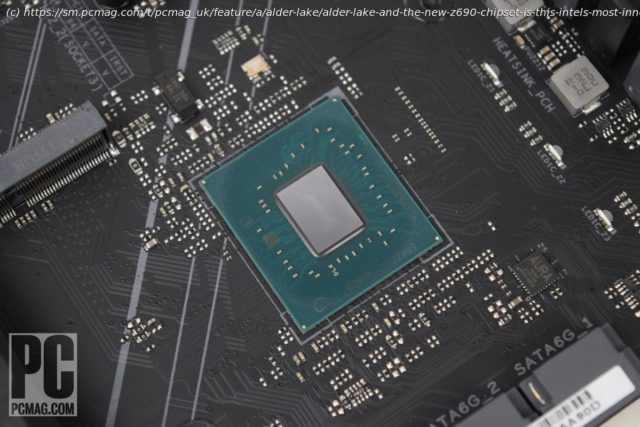With feature updates galore, paradigm-changing DDR5 memory, and much more, the technology backing Intel’s 12th Generation Core CPUs is just as interesting as the chips themselves. We’ve got a breakdown.
Intel’s 12th Generation Core processors, code-named « Alder Lake, » debut today, and a big part of the rollout party, as always, is a new high-end chipset. But this is not another mere ordinary « Z »-series chipset launch. Intel’s new Z690 marks the biggest change in Intel’s motherboard chipsets in nearly a decade. With the introduction of Alder Lake, Intel is transitioning from DDR4 to the newly emerging DDR5 RAM, with a host of new capabilities and tweaking possibilities. The Z690 chipset is facilitating this move with the introduction of a new version of the classic Extreme Memory Profiles—XMP 3.0—and a brand-new memory-speed technology that Intel has named Dynamic Memory Boost. The chipset has several other new features baked in, including fresh overclocking tools to handle the Alder Lake CPUs’ unusual multi-core design. Before diving into this article, it would be helpful to first read through our coverage of the new Intel 12th Generation Alder Lake CPUs. To summarize the information in that article, Alder Lake processors utilize a multi-core design with large CPU cores that are optimized for performance and smaller cores that are designed to be more energy-efficient. This is similar to the « big. LITTLE » paradigm on ARM-based SoCs, but with Intel hardware and some software elements to help manage the workload between the two types of cores. Alder Lake also ships with native support for DDR5 memory (though some motherboards will ship with DDR4 support), as well as support for the nascent PCI Express 5.0. Let’s start with that. PCI Express 5.0 Is Here…for the Future In total, in the new chipset the CPU is allocated 20 PCI Express (PCIe) 5.0 lanes,16 of which are dedicated for graphics cards and cannot be used for anything else. By default, all 16 of these will be tied to the primary PCIe x16 slot. Z690 motherboards that have a second PCIe x16 slot can be configured to have this split in half and shared between the two PCIe x16 slots to facilitate a multiple-GPU configuration. Asus ROG Strix Z690-E motherboard The remaining four PCIe 5.0 lanes are intended for use with M.2 NVMe SSDs. Currently, of course, there aren’t any PCIe 5.0 NVMe SSDs on the market, though prototypes have been shown. But if there were (and we assume they will eventually come to the mainstream consumer market), this new platform would support them with a maximum theoretical bandwidth of up to 128Gbps. That said, until PCIe 5.0 NVMe drives show up, this connection can still be used for any M.2 PCIe 3.0 or PCIe 4.0 NVMe SSDs. It’s essentially a form of future-proofing for buyers of high-end motherboard platforms with the new Intel chips. Chipset PCIe 4.0 and SATA The Z690 chipset itself now has support for up to 12 PCIe 4.0 lanes, which the outgoing Z590 chipset lacked. Like the extra four PCIe 5.0 lanes on the CPU, these will mostly be useful for M.2 NVMe SSDs and other high-speed interfaces that the motherboard maker may integrate, such as Thunderbolt controllers. For less data-hungry devices (such as Wi-Fi chips or sound cards or chipsets), the Z690 has up to 16 PCIe 3.0 lanes available that should supply plenty of bandwidth to these devices. Like with previous generations of Intel chipsets, some of the PCIe lanes share a data connection with other devices. For example, the Platform Controller Hub (PCH) can support eight Serial ATA (SATA) 3.0 ports, but using some of these will remove either a PCIe 3.0 or PCIe 4.0 lane from use elsewhere. Intel Z690 chipset diagram, detailing connection options Given the total number of lanes available, though, and the declining use of SATA 3.0 devices as M.2 and NVMe devices take over the storage space (SATA is mostly just used for spinning-platter hard drives, at this point), this doesn’t appear problematic. It’s actually more surprising to see that the Z690 can natively support eight SATA 3.0 devices, as essentially all Intel chipsets in the last decade have supported no more than six SATA devices. DMI 4.0: Double the Bandwidth A bit of background first: DMI, or Direct Memory Interface, is the connection used to glue together virtually everything except RAM and the graphics card to the CPU. The DMI lanes function similar to PCIe lanes, with DMI 4.0 having bandwidth parity with PCIe 4.0. In turn, the Z690 chipset functions essentially as a PCIe device connected to the CPU just like a graphics card…except instead of sending graphics data, the chipset enables the CPU to connect to dozens of other devices. That includes all USB, audio, internet, and storage devices through the chipset and the DMI 4.0 connection. Any data passing from any of these devices to the system’s RAM also has to pass through this same connection, which is why having adequate bandwidth for the DMI connection is critically important.
Home
United States
USA — software 'Alder Lake' and the New Z690 Chipset: Is This Intel's Most Innovative...






